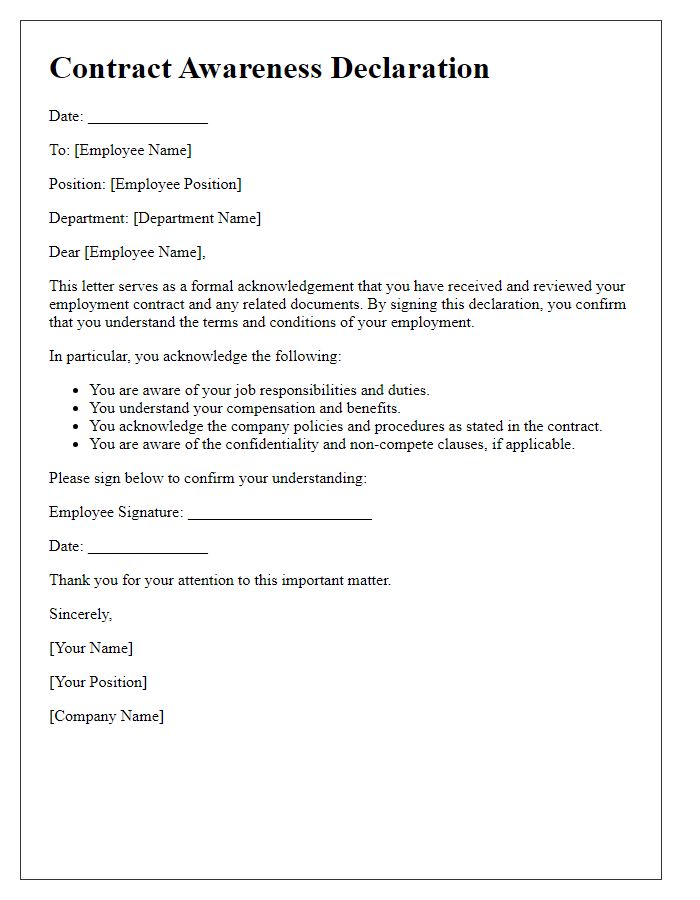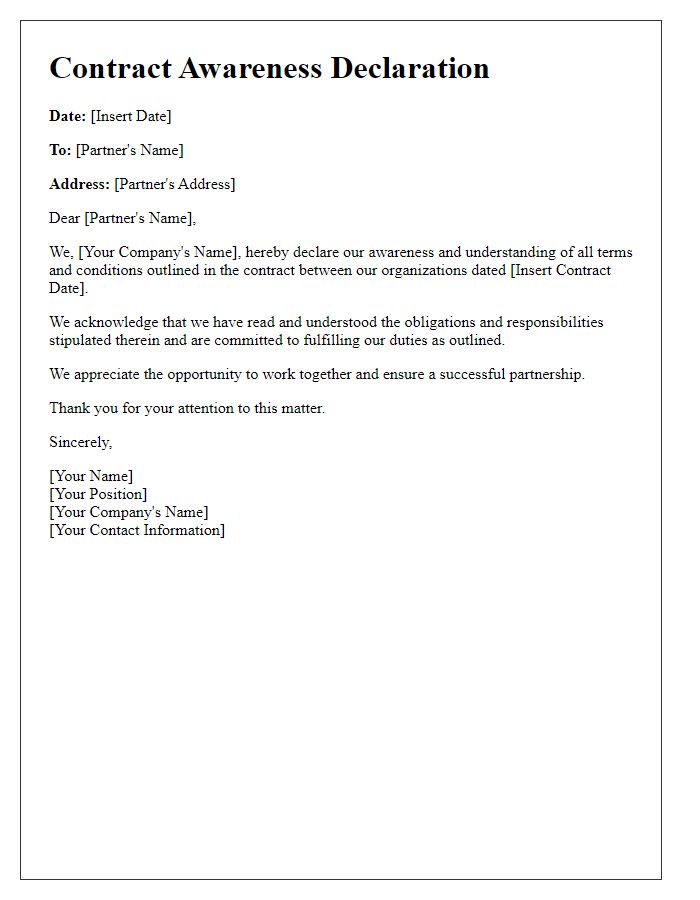Hey there! Have you ever found yourself confused about the details of a contract you're about to sign? Understanding the fine print is crucial, as it can save you from unexpected surprises down the line. In this article, we'll share a straightforward letter template for a contract awareness declaration, ensuring you're fully informed before committing. So, let's dive in and explore how to protect yourself and navigate those contracts with confidence!

Clear Purpose Statement
A clear purpose statement identifies the intent behind a contract awareness declaration in legal and business contexts. This statement typically outlines the importance of understanding contractual obligations, rights, and responsibilities. It emphasizes the necessity for all parties involved--such as the signatories who may include individuals or corporate entities--to be fully informed about the terms of the contract (specific conditions, timelines, penalties for breach). The declaration serves as a formal acknowledgment that all parties have read, understood, and agree to adhere to the contract's provisions, fostering transparency and accountability. This process is crucial in mitigating disputes and ensuring compliance in various sectors, including real estate agreements, employment contracts, or service-level agreements in technology sectors.
Identification Details
Identifying details are crucial in establishing the authenticity of contract awareness declarations. The full name of the declarant should be clearly stated, including any middle initials or suffixes (e.g., II, Jr.). The residential address must include the street name, number, city, state, and postal code to ensure accuracy. Identification numbers, such as a government-issued ID number or employee number, can further verify the individual's identity. Date of birth (format: MM/DD/YYYY) adds an additional layer of identification. For business contexts, the corporate name and registered address of the organization are necessary to distinguish between various entities involved in the contract. Additionally, contact details including telephone numbers and email addresses facilitate communication and verification processes.
Acknowledgment of Terms
Contract awareness declarations play a crucial role in ensuring that all parties involved recognize and accept the terms outlined in a contractual agreement. Individuals engaging in these contracts must read, understand, and acknowledge key aspects such as duration, scope, and obligations to avoid future disputes. Essential components often include termination clauses specifying conditions for ending the contract, liability limitations protecting against unforeseen circumstances, and payment terms detailing the timeline and method of compensation. This acknowledgment process ensures that entities, whether businesses or individuals, maintain transparency and accountability throughout their contractual relationships.
Signatures and Dates
A contract awareness declaration outlines an individual's understanding of their rights and obligations under a specific agreement. Parties involved in such a declaration must include clear identification details, such as full names, roles, and any relevant affiliations. Signature lines provide space for each participant to sign, indicating their consent and acknowledgment of the terms. Dates next to signatures mark the official moment when each party confirms their awareness of the contract, ensuring legal validity. Other details may include witness signatures and printed names to verify the authenticity of the agreement.
Legal Compliance Reminder
Legal compliance reminders serve to enhance awareness of contractual obligations within organizations. Regular assessments ensure adherence to regulations such as the Sarbanes-Oxley Act, influencing financial reporting practices in public companies. Teams should review key contracts, focusing on terms such as non-disclosure agreements and service level agreements, especially in industries like technology or healthcare, where data protection is vital under laws like GDPR (General Data Protection Regulation). Additionally, maintaining awareness of local, state, and federal laws, including employment regulations, fosters a culture of compliance and mitigates risks associated with legal disputes or penalties. Regular training sessions and updates reinforce the importance of this compliance culture within the organization.
Letter Template For Contract Awareness Declaration Samples
Letter template of contract awareness declaration for service providers.













Comments